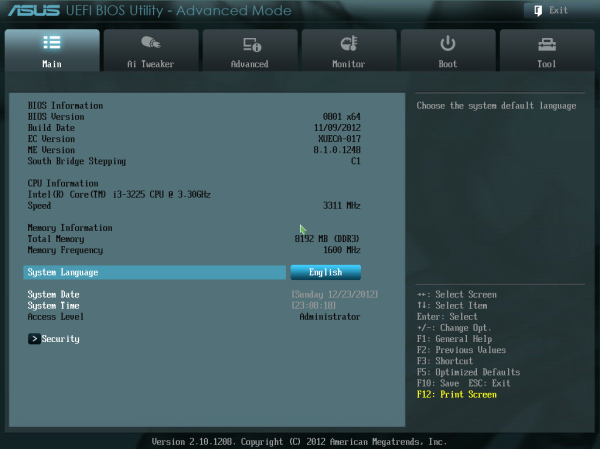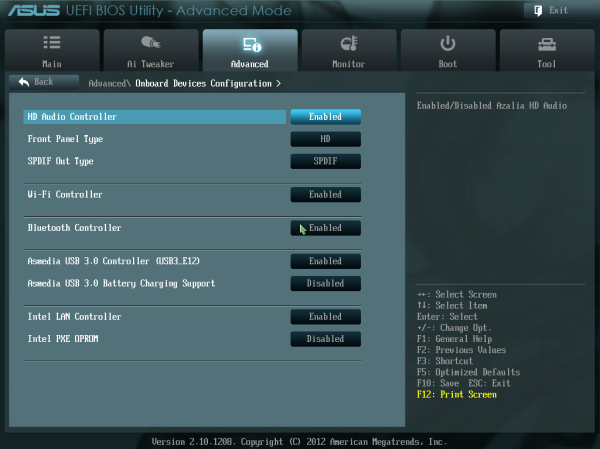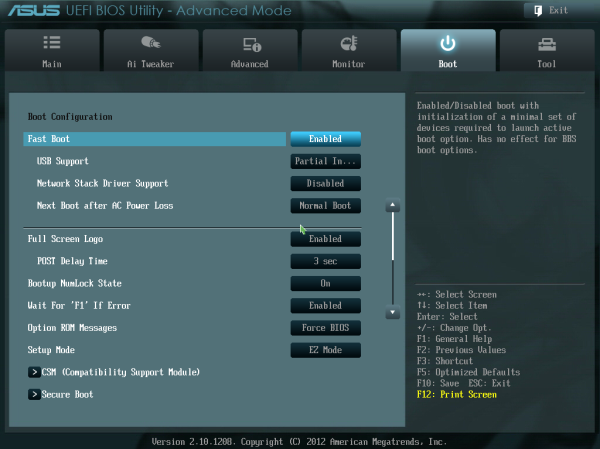Z77 mITX Round-Up: Five of the Best – MSI, Zotac, ASRock, EVGA and ASUS
by Ian Cutress on December 31, 2012 7:00 AM EST- Posted in
- Motherboards
- MSI
- ASRock
- EVGA
- ZOTAC
- Asus
- Ivy Bridge
- Z77
- mITX
ASUS P8Z77-I Deluxe BIOS
The BIOS from ASUS has been a rock solid part of their motherboard package since the advent of graphical BIOSes on mainstream motherboards hit a couple of years ago. ASUS divides functionality at the top level, providing an easy mode with images and bars to help identify the main points of the product, as well as a one button click for greater performance and boot priority. The other side of the coin is in advanced mode, where the feature sets are laid out to make sense to the user, and all options take the form of the old text-based BIOS. This lays the plans down for other features of the system, like USB BIOS Flashback.
While the BIOS from ASUS is one of the best on offer out of all the motherboard manufacturers today, there is room for improvement in all of them. The beating heart of a graphical BIOS should be functionality, representation of those functions, and usability. Very rarely do I ever see all three meshed together. Part of this is down to the size of the BIOS – even ASUS limit themselves to a 64 megabit BIOS chip, meaning 8 MB of storage to play around with for all the initialization procedures and protocol. It makes efficiency important in BIOS coding, and vendors are unwilling to double the size of the BIOS because of the additional cost. With the motherboard market in decline, innovation in this area is unlikely any time soon, but with bulk buying deal, ASUS could lead that charge. Then all would be left to do is to encourage the BIOS engineers and developers to create something.
The ASUS BIOS however is one of the best available today. The front ‘easy’ mode screen is full of information that a system builder or diagnostician needs before opening up a case – we get access to the motherboard model, BIOS version, CPU installed, the size of the memory installed, CPU and system temperatures, fan speeds, voltages and the boot order. There are options to apply a basic turbo mode, a power saving mode, a Boot Menu to select which device to boot from and shortcuts to advanced mode features.
Stepping into the advanced mode gives us a tabbed interface of options. When first entering we are presented with the Main screen, which offers similar data to the easy mode, as well as security options.
The next tab along is the AI Tweaker, where all the cool stuff happens. Users can choose to overclock their system through this menu, with options for CPU multiplier, CPU base frequency, MultiCore Enhancement, XMP on the memory, separate memory straps, and associated voltages. There are separate menu options as well to deal with memory timing, power management, and the DIGI+ VRMs.
The Advanced menu is for enabling and disabling the functionality on board – this extends to processor functionality (to disable sleep states), SATA functionality, USB functionality, Rapid Start, Smart Connect, integrated graphics, PCIe configuration and onboard devices such as audio, network, WiFi and Bluetooth.
Fan controls are hidden in the Monitor tab, which gives us details on temperatures, fan speeds and voltages. The fan options are relatively basic compared to those offered in the OS, despite the fact that the graphical BIOS way of thinking should offer some form of stepped graphical control over fan speeds. I look forward to seeing it on future BIOS designs.
The Boot tab allows users to adjust the boot order or select a device for a single boot override. Users of Windows 8 can also take advantage of the Fast Boot option which reorganizes the initialization procedure at POST in exchange for not being able to get into the BIOS without a BIOS reset or selecting an OS software option.
The ASUS BIOS also supports BIOS flashing if the correct file is on an attached storage device, although not directly from the internet. A newer feature in ASUS’ offering allows users to save BIOS profiles direct to a USB stick as well.
Another feature to mention is USB BIOS Flashback, which allows users to update a BIOS without having a CPU, memory or a graphics device installed. With the correct BIOS file and filename on a USB stick, by pressing a button on the IO panel, it will update the BIOS onboard (exact procedure is listed in the manual).























54 Comments
View All Comments
mike_b - Monday, December 31, 2012 - link
Interesting article, but I have to ask why would someone spend more for a Z77 chipset when using 'just' an i3? Surely a much cheaper H61 chipset could do the job admirably, and at much lower cost.Z77 makes sense if you're overclocking, which is excluded from this test...
IanCutress - Monday, December 31, 2012 - link
H61 has no chipset USB 3.0, no chipset SATA 6 Gbps, and you are limited to PCIe 2.0. H61 is also technically limited to one single sided DIMM per channel, and no SATA RAID. There's also SRT to consider, that would be advantageous with the ASRock and the mSATA on the rear.Ian
mike_b - Monday, December 31, 2012 - link
It might make an interesting comparison to see what net advantage is gained with the added features of the Z77 chipset compared with the H61. If budgets are limited the ~100 dollar cost difference between the Z77 and H61 mainboards makes a big difference; that money saved could be put into something which makes more of a performance difference (SSD rather than HDD for example).Anandtech is one of the best tech sites around, you guys do a great job. I do sometimes see though an emphasis on more expensive products when in terms of real-world performance you could get almost the same thing at a much cheaper price. Might be worth mentioning somewhere.
Not least because with yet another new socket coming with Haswell all these 1155 boards will be seen as out of date soon anyway.
IanCutress - Monday, December 31, 2012 - link
Once we get into the swing with Haswell, we will hopefully covering the whole spectrum. Though it is worth noting that motherboard manufacturers, want to put their best foot forward, and would prefer their halo/channel boards get covered before their OEM / low end offerings. Hence this is why you rarely see many mainstream reviews that are not from forums dedicated to the market segment and users testing their own equipment. We are hoping to rectify the balance in due course. If there are any specific products you might want us to test or examine, drop me an email and I'll see what I can put in my schedule (as full as it is[!]) :)Ian
StormyParis - Monday, December 31, 2012 - link
This is a major issue, not limited to motherboards: whenever I'm looking for something middle of the road or outright cheap, I can't find reviews.These Z77 MBs are a nice example: even though I'm recommending/building PCs regularly, most of them mini-ITX, I never came across a use case for Z77. Nobody apart from teens that still have something to prove overclocks anymore. People who want to do multi-GPU get a big case, and a big board. Are we supposed the extrapolate that the makers of good Z77 boards also make good H77 and H61 boards ?
I understand you've got to make do with what you're given by the OEMs. And that reviews was very good, as usual. Pity it is irrelevant ?
Tech-Curious - Monday, December 31, 2012 - link
That's an interesting observation. I have to say, I never noticed a significant lack of coverage for low-to-mid-range components (either in general or on Anandtech in particular), until this Fall, when I was in the market for a lower end motherboard.I guess I just always gravitated to higher end mobos before. Or maybe the coverage for such products was more comprehensive years ago. My memory's foggy, so it's hard to say.
In any case, motherboards appear to be the exception. If anything, I think the internet has generally grown more bullish on low-to-mid-range CPUs and GPUs in recent years (probably, in part, as a result of the stagnating console situation, which results in stagnating system requirements for games).
But all of that rambling aside, yeah. It'd be nice to see more diverse motherboard analysis. When I bought a b75 a couple of months ago, I literally couldn't find a review for that chipset. It wasn't a big deal; it's not like b75's features are any great mystery, after all -- but it is a little nettlesome to trip over sixty bajillion z77 reviews when there's nary peep about any other chipset.
In other news, Ian's review is a good one -- and given that I've been a faithful user of Asus motherboards for the last 15 years, it's nice to see them take home the prize. :)
Etern205 - Saturday, January 5, 2013 - link
My guess would be, why review a cheap board when majority of the readers here won't even bother buying it?And as for Asus boards, I've heard, they do something called based-line features. This means all boards from the bottom of the range to the top (Intel B75-Z77) will have the same base-line features, other features are just added like BT, WiFi, extra lan, etc.
Tech-Curious - Wednesday, January 9, 2013 - link
Yes, I think the issue is that (at least with respect to Intel chipsets) low-end motherboards don't support overclocking. So they're both less interesting to review (fewer measurable differences in performance among different models), and they're less appealing to the presumed audience of sites like Anandtech.Still, the B75 is a perfectly good chipset. If you aren't heavily invested in overclocking, z77's advantages are likely wasted on you. Personally, I'm well beyond my overclocking days; I just don't have the time or the patience to go through the almost endless tuning process anymore. (Even if you find a stable OC at the outset, it can become unstable later, and/or a given application might expose instability that stress testing didn't, weeks or even months down the road).
jonjonjonj - Friday, January 4, 2013 - link
just cause you don't overclock doesn't mean other people don't. why wouldn't you? because you want to get the fastest cpu that you can afford means you have something to prove? some people are just idiots.Zap - Monday, December 31, 2012 - link
But there isn't a $100 difference between H61 and Z77. There is a cheaper Gigabyte Z77 ITX board that's only around $60 more than the cheapest H61 ITX board, and it was even on sale recently for another $13 off making it less than $50 difference.Alternately one can go the H77 ITX route and get all the Z77 goodies except for overclocking, for around $30 less than the cheapest Z77 ITX. I think $30 more than H61 is reasonable for those extra features, plus guaranteed out-of-the-box BIOS support for Ivy Bridge.
I do agree with your (mike_b) first post regarding the choice of CPU used. Ian Cutress, didn't you have a spare K CPU laying around? There are so many people building overclocked ITX rigs these days. I did in a Silverstone SG05 with low profile air cooler to hit 4.2GHz. Plenty of others use the Bitfenix Prodigy and liquid cooling to hit clocks normally reserved for ATX rigs. Another review site (Tweaktown) tested overclocking on Z77 ITX boards and the ASRock hit near 4.8GHz. THAT'S what I want to see.
Of course this AnandTech roundup has some very useful information too, such as DPC latency tests and POST times. Keep up the good work there! But please, know your audience. Next time if the board is supposed to be overclockable, test that feature.
Maybe there can be a companion article about overclocking and heatsink clearance? Would be a shame to not overclock this nice collection of Z77 ITX boards.